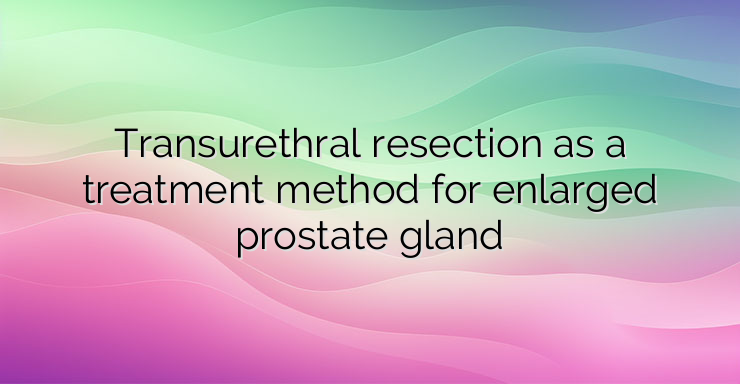What is transurethral resection of the prostate? Transurethral resection of the prostate (TURP) is a surgical procedure and a bloodless method of treating an enlarged prostate gland that involves cutting away (resecting) part of the prostate. The prostate is a small gland in the male pelvis and is part of the male reproductive system. It is located between the penis and the bladder and surrounds the urethra (the channel through which urine passes from the bladder to the penis). If the prostate enlarges, it can put pressure on the bladder and urethra, which can cause symptoms such as difficulty urinating. Why is transurethral resection of the prostate performed? Transurethral resection of the prostate is often recommended when an enlarged prostate causes complaints and does not respond to drug treatment. Symptoms that may improve after TURP include: Trouble starting to urinate; Weak flow of urine; Frequent need to urinate; Getting up frequently at night to go to the toilet (nocturia); Sudden urges to urinate; Inability to completely empty the bladder How is transurethral resection of the prostate performed? Transurethral resection of the prostate (TURP) is performed using a device called a resectoscope, which is a thin metal tube containing a light source, a camera, and a special loop (called a resection electrode). The camera provides a magnified image of the structures that are observed on a screen. The resectoscope is passed along the urethra until it reaches the prostate, which means that there is no need to make incisions in the patient’s skin. The loop is then heated with a high-frequency electric current and used to cut off the part of the prostate that is causing the symptoms. The operation ends with the insertion of a catheter, which is worn for some time by the patient, to flush the bladder and to prevent the formation of blood clots. General or spinal anesthesia is used during the procedure. What are the risks of transurethral resection of the prostate? In most cases, TURP is a safe procedure and the risk of serious complications is very low. However, in some cases, a man’s ability to ejaculate seminal fluid during sex or masturbation is lost, although he still experiences physical pleasure from ejaculation (orgasm). This is known as retrograde ejaculation. Some men also lose the ability to control their bladder (urinary incontinence), although this usually goes away after a few weeks. In rare cases, additional treatment may be needed. There is also a small risk of problems such as erectile dysfunction, difficulty urinating and urinary tract infections. What are the alternatives to transurethral resection of the prostate? There are a number of alternatives to TURP that can be just as effective with a lower risk of complications, these include:PLASMA system � electrodes are inserted into the prostate through the urethra and used to cut out prostate tissue; Holm laser enucleation of the prostate (HoLEP) � a laser attached to a resectoscope is used to cut out excess prostate tissue; Transurethral laser resection or vaporization of the prostate � a thin tube called a cystoscope is inserted into the urethra and a laser attached to the cystoscope emits energy pulses to burn the prostate tissue; Prostatic urethral lift (PUL) implants � a surgeon inserts implants that hold the enlarged prostate away from the urethra. The implants lift and compress the enlarged prostate so that it no longer blocks the urethra and this helps to relieve problems such as pain or difficulty urinating. These procedures are not suitable for all men with an enlarged prostate. A specialist should discuss possible treatment methods with each patient. References: 1. National Health Service (NHS). Transurethral resection of the prostate (TURP) 2. Mayo Clinic. Transurethral resection of the prostate (TURP) 3. Cleveland Clinic. Transurethral resection of the prostate


Leave a Reply